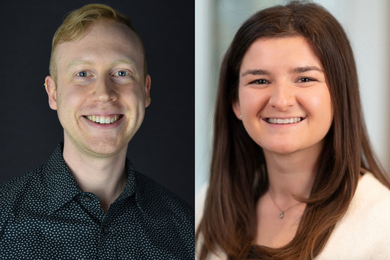MIT's legal fight for need-based financial aid has been joined by the Philadelphia public schools, associations for hundreds of colleges and the Rockefeller Brothers Fund, all of which are seeking to file friend-of-the-court briefs in the antitrust action against the Institute.
The Justice Department's Antitrust Division has orally refused to consent to the filing of the first of the briefs presented, according to lawyers for the organizations seeking to place them before Chief Judge Louis C. Bechtle of the US District Court in Philadelphia. Testimony in a 10-day, non-jury civil trial before Judge Bechtle ended July 9.
The initial briefs were filed by 20 organizations which represent most of the four-year colleges in the United States, including state universities, independent colleges, Catholic universities and the United Negro College Fund.
On July 30 the American Council on Education (ACE) and 11 other groups sought to file additional briefs. Atty. Eugene Gulland of Covington and Burling in Washington, lawyer for ACE's 1,500 educational institutions, said the case "presents issues of surpassing importance to higher education in the United States."
The groups involved in this effort include the ACE; the United Negro College Fund (41 private colleges); The College Board (2,800 institutions); the Association of American Universities (56 research institutions); the Association of Catholic Colleges and Universities (202 institutions); the Association of Jesuit Colleges and Universities (28 institutions); the National Association of State Universities and Land Grant Colleges; the National Association of Independent Colleges and Universities (840 institutions); the Council of Independent Colleges; the Association of American Medical Colleges (526 institutions); the National Association of Student Financial Aid Administrators (3,000 institutions); and the National Association of Student Personnel Administrators.
First amendment issue
The brief this group filed said, "The financial aid policies that the Justice Department challenges here lie at the heart of the constitutionally protected freedom of a university to make its own judgments as to . . . the selection of its student body." The brief cited the words of the 1978 US Supreme Court decision in Regents of the University of California v. Bakke, saying that Overlap (the name for the process by which MIT sought to ensure need-based financial aid) "embodies the goal cited in the Bakke case of 'achieving the educational diversity valued by the First Amendment.' "
Two other separate requests to file friend-of-the-court briefs were made by seven Philadelphia groups and the Rockefeller Brothers Fund on Friday, July 24.
The Philadelphia public schools, the Urban League of Philadelphia, and five local groups of civic leaders and lawyers said, "The Friends of the Court support MIT's policies of need-blind admissions and need-based financial aid and urge this Court to repel the Antitrust Division's efforts to eliminate them. The Antitrust Division has not met its burden of proving that Overlap is an unreasonable restraint on competition that results in an economic injury," they wrote. The brief was filed by the School District of Philadelphia, the Urban League of Philadelphia, the Greater Philadelphia Urban Affairs Coalition (whose board of nearly 100 civic leaders includes a dozen corporate chief executives and three leaders of labor unions), and four associations of lawyers-the Barristers Association of Philadelphia, Inc. (about 1,000 African-American lawyers); the Hispanic Bar Association of Pennsylvania; the Asian American Bar Association of the Delaware Valley (Pennsylvania, New Jersey and Delaware); and the National Bar Association Women Lawyers Division, the Philadelphia chapter of more than 450 African-American women attorneys.
In its brief, the Rockefeller Brothers Fund (RBF) said it has an interest in the case "because it is a charitable organization that is active in promoting and supporting educational opportunities for minority college students and is familiar with the way charitable organizations make their decisions with regard to awarding grants and allocating scarce charitable resources."
'Strengthens economy'
The Rockefeller brief said, "It should not be a matter of debate that access to higher education by the maximum number of Americans fulfills important goals of American society and strengthens the American economy. . . Indeed, access to higher education is a necessity if there is to be true equal opportunity. . .
"Given our national aspirations and national interests, it is perverse to create more obstacles to the education of needy Americans. . . The interplay between 'need-only' student financial aid and a socially and economically strong America is magnified by the changing demographics of our country. The minorities of America today are the emerging 'majority' of America tomorrow. . . For members of some minority groups, higher education is not traditionally valued, and the benefits of deferring entry into the work force in order to pursue a higher education are not always self-evident . . . The non-financial obstacles to their matriculation need to be overcome, and those obstacles should not be made to loom larger by increasing the financial obstacles."
Referring to the Overlap process, the Rockefeller brief said, "Allocating aid in this fashion is a prudent use of charitable assets and a wise investment in America's near-term and long-term future. Colleges should be allowed to make such allocations by the most efficient and effective means available."
MIT memorandum
In its 47-page "Post-Trial Memorandum" to the court, filed July 24, MIT said: "Simply stated, Overlap involved coordination among nonprofit organizations, which sought to achieve the fairest allocation of limited private charitable funds, in order to most effectively attain charitable goals embraced by the government-in a 'market' in which the final 'product' is subsidized and provided below cost for all 'buyers,' given outright to some who cannot afford it, and withheld from others who could and would pay a great deal for it if only the 'sellers' would sell to them.
"No antitrust decision has ever held such conduct to constitute commercial behavior to which the antitrust laws would apply. Indeed, no commercial firm could engage in such practices and remain in business beyond the time it took to exhaust its bank account."
MIT noted contradictory attitudes by the Department of Justice in the MIT antitrust trial, which began June 25, and in a Justice Department brief of the very next day, June 26, in another case, US v. Fordice, a civil rights case in Mississippi.
"It is worth noting," MIT said, "that the same government agency which claims that MIT's goals of equal educational access and opportunity are 'irrelevant' to the antitrust inquiry, recently concluded 17 years of litigation against the state of Mississippi for obstructing equal access to state colleges. In that case, the Department of Justice claimed that Mississippi was obligated to 'ensure that each of its young people be free to choose among all that the state has to offer, limited only by ability and not by race.'
"Here, however, the Department of Justice maintains that it is illegal for private colleges to work cooperatively toward the same result," MIT wrote.
MIT cited a recent decision in the National Organization for Women, Inc. v. Scheidler, handed down June 29 in the Seventh Circuit Court of Appeals (Indiana, Illinois, Wisconsin). MIT said, "The Seventh Circuit noted that 'the [Sherman] Act was not intended to reach the activities of organizations espousing social causes' but rather 'was intended to prevent business competitors from making restraining arrangements for their own economic advantage.'"
The Seventh Circuit also commented in the case that "it is hard to ignore the suspicion that the facts have been forced into an antitrust mold to achieve federal jurisdiction."
Referring to the Antitrust Division's financial aid case against MIT, MIT said, "In the present case, too, it is hard to ignore the suspicion that what gives rise to this litigation is a dispute over social goals, and that this dispute has been awkwardly forced into the antitrust mold by regulators who, because of their limited authority, have no more appropriate tool. Like the Seventh Circuit, however, this Court should not permit the antitrust laws to be misused either to intervene in a dispute over social goals, or to expand the jurisdiction of an agency reaching to explore new horizons."
MIT said the "cooperative activity involved in Overlap can also be justified under a rule of reason analysis for non-economic reasons." MIT cited the dissent by US Supreme Court Chief Justice William H. Rehnquist and Justice Byron White, in National Collegiate Athletic Association v. Board of Regents of the University of Oklahoma (1984), in which they said:
"The primarily non-economic values pursued by educational institutions differ fundamentally from the 'overriding commercial purpose of day-to-day activities' of engineers, lawyers, doctors, and businessmen, and neither Professional Engineers nor any other decision of this Court suggests that associations of nonprofit educational institutions must defend their self-regulatory restraints solely in terms of their competitive impact, without regard for the legitimate noneconomic values they promote."
MIT said the Antitrust Division's expert economic witness, Dr. Keith Leffler, based his initial conclusions on economic theory of profit-maximizing organizations, using unreasonable benchmarks. The government expert used "an uncontrolled comparison" involving "a limited set of data" and claimed as significant a statistical regression that MIT asserts was not significant. MIT also said that a second Leffler regression contained data from only 15 schools and therefore was "statistically suspect." MIT said, consequently, that "Dr. Leffler's conclusion is not supported by the evidence."By contrast, MIT said, its expert economist, Dr. Dennis Carlton, performed a detailed, statistically sound analysis of the economic impact of Overlap on the average net revenue per student received by the Overlap colleges. It revealed that there is no statistically significant effect of Overlap on average net revenue, and therefore no scientific basis for the conclusion that Overlap increased price. The results reveal that the most likely effect of Overlap was to reduce average net revenue, not increase it, MIT asserts.
MIT brought out some other points from the trial in a 68-page separate document, "Proposed Findings of Fact and Conclusions of Law," it filed with the federal district court.
- Approximately 99 percent of all federal financial aid awards are based solely upon need.
- Federal aid in loans and grants in 1988-89 satisfied only 30 percent of the average $13,300 need of MIT financial aid students, as calculated under the federal formula; 90 percent of this federal aid was awarded in the forms of loans and 10 percent was awarded in the form of grants. The aid awarded by MIT was 90 percent in the form of grants and only 10 percent in loans.
- If a student receives any federal money based on financial need, all financial aid funds-both federal and institutional-must be based on need. To award funds beyond need is an "overaward" prohibited by the US Department of Education, which audits college financial aid programs to ensure compliance with the law. Thus, if schools were to provide "no-need aid" as the Antitrust Division seeks, the schools would have "a strong incentive to channel" such aid "to wealthy students."
- The US Department of Education conducts comprehensive financial aid audits of colleges and has been aware of the Overlap process for three decades. In 1989, the Department awarded MIT a Certificate of Superior Performance for its compliance with the federal regulatory system concerning financial aid practices.
- Of the approximately 1.2 million students who enrolled during the 1991-92 academic year in a four-year college or university in the United States, only about 1 percent enrolled at MIT or one of the Ivy League schools.
A version of this article appeared in the August 5, 1992 issue of MIT Tech Talk (Volume 37, Number 2).





